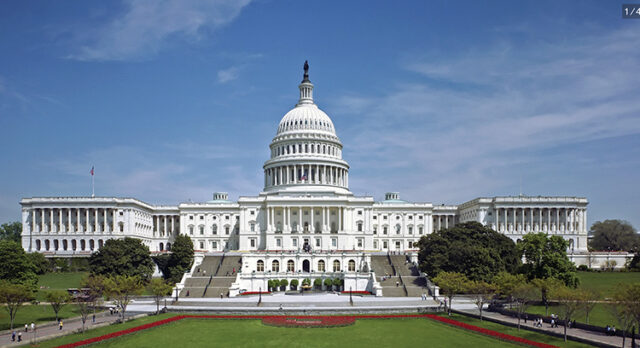
By The Circle
The federal government’s fiscal year ended at midnight Sept. 30 without a new spending deal in Congress, forcing the government into a shutdown that cut off dozens of services to tribal nations.
A shutdown was something tribes said they could not afford. Native nations and communities depended on federal personnel and programs for roads, police, energy, health care, food and other services.
In an article by Indian Country Today, Michael Stopp said, “We’re at a point now where the government is going to shut down.” Stopp, who is Cherokee and Muscogee, served as president and CEO of Seven Star Holdings. “The question is, how long is that going to happen and which side is going to blink?”
Health services at risk
During the shutdown, certain functions continued if deemed essential, including the Indian Health Service. IHS had six accounts not funded by advance appropriations and used prior-year balances to keep staff working.
But lease payments were not included in those appropriations. A prolonged shutdown threatens to prevent IHS from issuing payments to tribes, according to the National Congress of American Indians.
“Government shutdowns affect Indian Country more quickly and more broadly than they do everyday Americans because of our direct relationship with the federal government,” said Holly Cook Macarro, a Red Lake Ojibwe tribal advocate, political strategist and Democratic commentator.
Partisan gridlock
The shutdown stemmed from a standoff between Republicans and Democrats over the 2026 spending bill. Republicans controll both chambers of Congress, but the Senate remained short of the 60 votes needed to pass legislation.
“Republicans do not have much of an issue with letting the government shut down until they get what they want, and Democrats don’t usually have the stomach for it,” Stopp, a Republican commentator, said.
Democrats said they would not support the GOP bill unless it restored Medicaid cuts from Trump’s “big, beautiful bill” and permanently extended subsidies under the Affordable Care Act. They also opposed cuts to the Centers for Disease Control and Prevention and the National Institutes of Health.
Republicans had offered a temporary funding extension through Nov. 21. Democrats countered with an Oct. 31 deadline.
The longest shutdown in history lasted from Dec. 22, 2018, to Jan. 25, 2019, during Trump’s first term.
Federal workforce cuts
A memo from the Office of Management and Budget (OMB) signaled a departure from past shutdowns, encouraging agencies to consider layoffs instead of temporary furloughs. The OMB letter directed agencies to prepare mass reductions in force, following earlier efforts by the Department of Government Efficiency.
“The administration is taking this opportunity to further implement their priority of the reduction in the federal workforce, and these are permanent job losses,” Cook Macarro said.
About 30,600 federal employees are Native American, or 1.5% of the federal workforce, according to 2023 data. That number had likely dropped following workforce cuts in early 2025.
“We really need to double down and make sure we’re advocating for those positions that serve programs that go out to Indian Country,” said Liz Carr, a member of the Sault Ste. Marie Tribe of Chippewa Indians and vice president of intergovernmental affairs for the Cedar Rock Alliance. “Indian Country can’t afford a shutdown.”
Impact on Native communities
Federal trust and treaty obligations required the U.S. to provide education, policing and health care to Native nations. While those obligations did not end in a shutdown, the funding delays caused immediate strain.
The Bureau of Indian Affairs’ already underfunded tribal police faced further cuts. Officers continued working but without pay. Emergency response times in rural areas lengthened further.
Food programs such as the Food Distribution Program on tribal lands relied on reserve funding, though prolonged disruption threatened shortages.
The Department of Housing and Urban Development will shut down, halting Native housing programs and Indian Housing Block Grants.
Smaller tribal governments that depended heavily on federal dollars are especially vulnerable, with services such as domestic violence shelters and homelessness programs left in limbo.
“When I was much younger, my mother worked for IHS and we had a very long shutdown,” Stopp recalled. “She wasn’t getting paid, but she had to be at work, and we had a hard time putting food on the table. I hate these fights in Washington. It’s not those guys having this fight that suffers.”
Native voices in Congress
Of the five Native American and Indigenous members of Congress, views were split.
Rep. Tom Cole, R-Okla., Chickasaw, criticized Democrats for what he called stalling tactics. “The contrast with Democrats on this is telling,” he said in a press release. “It is wrong and they know it. House Republicans rejected that approach and chose stability, discipline and results instead.”
Rep. Sharice Davids, D-Kan., Ho-Chunk, urged bipartisan talks. “Instead of canceling votes and continuing to push partisan agendas, it is time for members to reach across the aisle and be open to compromise,”
Services continuing despite shutdown
The Indian Health Service announced Oct. 1 that its operations will continue during the federal shutdown. Because the agency received advance appropriations for fiscal year 2026, IHS clinics and programs are expected to function normally.
Other major programs — including Social Security, Medicare, Veterans Health Administration facilities, the Supplemental Nutrition Assistance Program, and the U.S. Postal Service — also remain open to the public.
Public safety will continue as well. Bureau of Indian Affairs police departments are considered essential and will stay on duty, although officers’ paychecks will be delayed until Congress resolves the budget impasse.
Some tribes may see disruptions in other areas. For example, the Lower Brule Sioux Tribe — where most land is leased by tribal members and organizations — could face slower turnaround times for lease payments from the Department of the Interior. Federal officials have said those payments will eventually be made once funding resumes.
“Shutdowns land hardest on our people,” said Larry Wright, Jr., Executive Director of the National Congress of American Indians. “Tribal leaders do what they’ve always done: show up for their citizens, keep clinics open, protect public safety, and care for our elders and children. As sovereign governments we should not have to uphold these commitments we made to our citizens at the expense of federal inaction. The United States must uphold its trust and treaty obligations regardless of the circumstance and without interruption.”
Even as Tribal governments work tirelessly to cover federal shortfalls, shutdowns force them to either spend limited resources upfront or divert money from other essential programs. Many Nations take on significant financial risk in doing so, stretching already tight budgets, overwhelming staff, and disrupting long-term planning.






